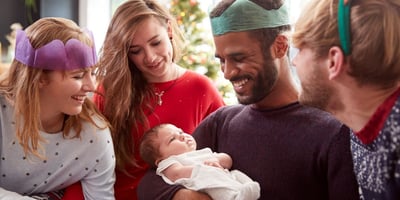Intended parents using assisted reproduction (other than surrogacy) in California can use state...
Lucina Scale 101
The Lucina Scale is a straightforward way for families and donors to indicate their preference for contact after conception.
The Lucina Scale acknowledges that connections and relationships are non-binary. Simply answering “yes” or “no” when asked: “Are you open to contact between the donor and family?” does not provide enough clarity for a communication agreement.
The Lucina Scale helps donors and families indicate a point (or range) on the scale with which they are comfortable.
.png?width=960&name=lucina_scale%20(1).png)
Why is this important?
Communication between donors and biological offspring is often an emotional topic. It can be difficult to triangulate the needs of the parent(s), child, and donor. Historically, the response to this has been anonymity: if the donor and families don’t know one another, there will be no possibility of (and no need for) contact.
This is rarely the case. Countless donor-conceived individuals have embarked on long journeys to discover a hidden half of themselves. The majority of adult donor-conceived individuals feel that limiting access to information about their donor is a violation of their human rights. Some donors would like to know how the children are doing, while other donors do not feel this need.
Parents worry that any connection with the donor will impact their relationship with the child they love and raise. It’s an understandable concern, and one that many parents – including same-sex couples and single moms by choice - share.
Using the Lucina Scale allows for intentional planning and protection before conception for parents, while honoring the right of donor-conceived children to their genetic identity.
The Scale
All Lucina donors are known. This means they provide information about their identity and relevant medical background.
0 - Open ID / No Involvement
A zero on the Lucina Scale indicates a willingness to share the donor’s identity with parents and provide relevant medical history, should the need arise. Donors and families who rate themselves as a zero would prefer no contact between the child and donor as they grow up. Donor-conceived children may reach out with questions once they turn 18, but it is unlikely donors will want any connection or relationship beyond this.
1 - Behind the Scenes / Milestone Updates
A one on the Lucina Scale indicates an interest in updates on important milestones, without any direct involvement. Donors may appreciate pictures and information as the child grows up, has birthdays, graduations, etc.
2- Pen Pal / Yearly Updates
A two on the Lucina Scale indicates a willingness to be known to the child and receive updates. A donor with preference of “2” is also open to the occasional, age-appropriate written correspondence with the child, organized by their family. This may include letters and emails.
3 - Acquaintance
A three on the Lucina Scale indicates that the donor and family are open to the child meeting the donor at least once throughout their childhood. They will have a frame of reference for how they are in-person, and may also like to be a pen pal or receive updates.
4- Family Friend
A four on the Lucina Scale indicates the possibility of the donor being present for special occasions that the family would invite friends to, such as birthday parties. They may interact with the child at these public events, and may also like to be a pen pal or receive updates.
5 - Uncle or Godfather
A five on the Lucina Scale indicates that the donor is open to being a consistent presence in the child’s life, perhaps acting as a mentor for the child or support system for the family.
6 - Coparent
A six on the Lucina Scale indicates a donor who would like to be present for the day-to-day, pitching in with the responsibilities of raising the child.



